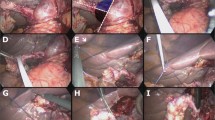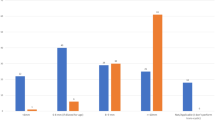Abstract
Background
Previous studies have been published evaluating the benefits and drawbacks of clearing the common bile duct of stones using a single-stage approach (LCBDE + LC) versus a two-stage approach (ERCP followed by LC). These studies have demonstrated that a single-stage approach offers similar outcomes and morbidities as a two-stage approach, with the added benefit of a lower cost and shorter length of stays. However, it is significant we understand why LCBDE is not commonly performed currently and also the lapse in surgical trainee exposure and competence in LCBDE. This paper aims to address the lapse in surgical trainee exposure to LCBDE, evaluate the scopes currently available to perform LCBDE, and review current data evaluating the risks and benefits of single-stage versus two-stage approaches to.
Methods
We utilized PubMed to analyze all publications related to the various disposable scopes utilized to perform choledochoscopy. We also discuss the need for disposable scopes and how this new market niche is transforming the choledochoscopy space.
Results
We analyzed the data related to single-stage and two-stage approach to choledocholithiasis. We noted an overall shorter length of stay and also decreased costs in favor of a single-stage approach.
Conclusion
A single-stage LCBDE is the most cost-effective treatment option for choledocholithiasis in patients with choledocholithiasis undergoing a cholecystectomy. In addition, single-stage approach is associated with shorter length of stay. Knowledge of the available choledochoscopes and tools available to surgeons to perform choledochoscopy is significant. The evidence does support the use of disposable choledochoscope from a cost and cross-contamination perspective. Additionally, efforts should be made to incorporate LCBDE into the teaching paradigm of surgical training programs.
Similar content being viewed by others
References
Cullen J (2006) Laparoscopic cholecystectomy: avoiding complications. In: Scott-Conner CE (ed) The SAGES manual. Springer, New York. https://doi.org/10.1007/0-387-30485-1_16
Collins C, Maguire D, Ireland A, Fitzgerald E, O’Sullivan GC (2004) A prospective study of common bile duct calculi in patients undergoing laparoscopic cholecystectomy: natural history of choledocholithiasis revisited. Ann Surg 239(1):28–33. https://doi.org/10.1097/01.sla.0000103069.00170.9c
Petelin JB (2003) Laparoscopic common bile duct exploration. Surg Endosc 17(11):1705–1715. https://doi.org/10.1007/s00464-002-8917-4
Wandling MW, Hungness ES, Pavey ES et al (2016) Nationwide assessment of trends in choledocholithiasis management in the United States from 1998 to 2013. JAMA Surg 151:1125
Campbell J, Pryor A, Docimo S (2022) Trancystic choledochoscopy utilizing a disposable choledochoscope: how we do it. Surg Laparosc Endosc Percutan Tech 32:616–620
Olympus (n.d.) True to Life. https://www.olympusamerica.com/. Accessed 3 Nov 2022
Olympus (n.d.) True to Life. https://www.olympus-global.com/company/profile/business.html?page=company#EndoscopeArea. Accessed 3 Nov 2022
Olympus (n.d.) True to Life. https://www.medwrench.com/equipment/9016/olympus-chf-p60. Accessed 3 Nov 2022
Olympus Medical Systems (n.d.) Superslim 7.95 fr flexible fiber uretero-renoscope urf-P7/P7R - olympus medical systems. URF-P7/P7R. https://www.olympus-europa.com/medical/en/Products-and-Solutions/Products/Product/URF-P7-P7R.html. Accessed 6 Nov 2022
Olympus. (n.d.) Origin of Endoscopes | Endoscopes | History of Olympus Products | Technology. https://www.olympus-global.com/technology/museum/endo/?page=technology_museum. Accessed 19 Oct 2022
Meyer GW (2022) Preventing infection transmitted by gastrointestinal endoscopy. UpToDate. https://www.uptodate.com/contents/preventing-infection-transmitted-by-gastrointestinal-endoscopy?search=endoscopes&source=search_result&selectedTitle=1~52&usage_type=default&display_rank=1#H71945020. Accessed 29 Jul 2021
Sharma D, Misba L, Khan AU (2019) Antibiotics versus biofilm: an emerging battleground in microbial communities. BMC 8:76. https://doi.org/10.1186/s13756-019-0533-3. Accessed 16 May 2019
GlobalData Healthcare. Disposable endoscopes set to disrupt the reusable endoscopes market. https://www.medicaldevice-network.com/comment/disposable-resusable-endoscopes/. Accessed 20 Jan 2021
Boston Scientific. EXALT Model D Single-Use Duodenoscope. https://www.bostonscientific.com/en-US/medical-specialties/gastroenterology/exalt/clinical.html
Ciocirlan M (2019) Low-cost disposable endoscope: pros and cons. Endosc Int Open 7(9). https://www.ncbi.nlm.nih.gov/pmc/articles/PMC6715437/
Bang JY, Sutton B, Hawes R, Varadarajulu S (2019) Concept of disposable duodenoscope: at what cost? Gut 68:1915–1917. https://gut.bmj.com/content/68/11/1915
Ambu. Ambu aScope Duodeno. https://www.ambuusa.com/endoscopy/gastroenterology
Ambu. Environmental impact of using endoscopes. https://www.ambuusa.com/endoscopy/pulmonology/environmental-impact
Bomman S, Kozarek RA, Thaker AM, Kodama C, Muthusamy VR, Ross AS, Krishnamoorthi R (2021) Economic burden of enhanced practices of duodenoscopes reprocessing and surveillance: balancing risk and cost containment. Endosc Int Open 9(9):E1404–E1412. https://doi.org/10.1055/a-1515-2591
Boston Scientific (n.d.) SpyGlass™ Discover Digital Catheter. www.bostonscientific.com. https://www.bostonscientific.com/en-US/products/single-use-scopes/spyglass-discover-digital-catheter.html. Accessed 19 Oct 2022
Shanghai SeeGen Photoelectric Technology Co., Ltd. (n.d.) Disposable Choledochoscope For PTCS/TCBDE/Laparoscope surgery. https://www.seegenmed.com/product/15.html. Accessed 19 Oct 2022
Daniel C, Pereira J, Prudente C, Constantino J, Sá M, Casimiro C (2018) Laparoscopic choledochoscopy with Ambu® aScope 3™ in the treatment of coledocholithiasis: a series of cases. J Surg Case Rep. https://doi.org/10.1093/jscr/rjy046
Scotland KB, Chan JYH, Chew BH (2019) Single-use flexible ureteroscopes: how do they compare with reusable ureteroscopes? J Endourol 33(2):71–78. https://doi.org/10.1089/end.2018.0785
Dornier MedTech (n.d.) AXIS™ Single-Use Digital Ureteroscope (Standard Deflection). https://dornierdirect.com/products/axis%E2%84%A2-single-use-digital-ureteroscope-standard-deflection. Accessed 1 Nov 2022
Liu JG, Wang YJ, Shu GM, Lou C, Zhang J, Du Z (2014) Laparoscopic versus endoscopic management of choledocholithiasis in patients undergoing laparoscopic cholecystectomy: a meta-analysis. J Laparoendosc Adv Surg Tech A 24(5):287–294. https://doi.org/10.1089/lap.2013.0546
Zhu HY, Xu M, Shen HJ, Yang C, Li F, Li KW, Shi WJ, Ji F (2015) A meta-analysis of single-stage versus two-stage management for concomitant gallstones and common bile duct stones. Clin Res Hepatol Gastroenterol 39(5):584–593. https://doi.org/10.1016/j.clinre.2015.02.002
Reinders JSK, Gouma DJ, Ubbink DT, van Ramshorst B, Boerma D (2014) Transcystic or transductal stone extraction during single-stage treatment of choledochocystolithiasis: a systematic review. World J Surg 38:2403–2411
Pang L, Zhang Y, Wang Y, Kong J (2018) Transcystic versus tradi-tional laparoscopic common bile duct exploration: its advantages and a meta-analysis. Surg Endosc 32:4363–4376
Navaratne L, Martinez IA (2021) Transductal versus transcystic laparoscopic common bile duct exploration: an institutional review of over four hundred cases. Surg Endosc 35(1):437–448. https://doi.org/10.1007/s00464-020-07522-7
Yan Y, Sha Y, Yuan W, Yuan H, Zhu X, Wang B (2022) One-stage versus two-stage management for acute cholecystitis associated with common bile duct stones: a retrospective cohort study. Surg Endosc 36(2):920–929. https://doi.org/10.1007/s00464-021-08349-6
Morrell DJ, Pauli EM, Hollenbeak CS (2022) Inpatient choledocholithiasis management: a cost-effectiveness analysis of management algorithms. J Gastrointest Surg 26(4):837–848. https://doi.org/10.1007/s11605-022-05249-5
Singh AN, Kilambi R (2018) Single-stage laparoscopic common bile duct exploration and cholecystectomy versus two-stage endoscopic stone extraction followed by laparoscopic cholecystectomy for patients with gallbladder stones with common bile duct stones: systematic review and meta-analysis of randomized trials with trial sequential analysis. Surg Endosc 32(9):3763–3776. https://doi.org/10.1007/s00464-018-6170-8
Prasson P, Bai X, Zhang Q, Liang T (2016) One-stage laproendoscopic procedure versus two-stage procedure in the management for gallstone disease and biliary duct calculi: a systemic review and meta-analysis. Surg Endosc 30(8):3582–3590. https://doi.org/10.1007/s00464-015-4657-0
Al-Habbal Y, Reid I, Tiang T, Houli N, Lai B, McQuillan T et al (2020) Retrospective comparative analysis of choledochoscopic bile duct exploration versus ERCP for bile duct stones. SciRep 10:14736
Topal B, Aerts R, Penninckx F (2007) Laparoscopic common bile duct stone clearance with flexible choledochoscopy. Surg Endosc 21:2317–2321
Helling TS, Khandelwal A (2008) The challenges of resident training in complex hepatic, pancreatic, and biliary procedures. J Gastrointest Surg 12:153–158
Sanchez A, Rodriguez O, Benitez G, Sanchez R, De la Fuente L (2010) Development of a training model for laparoscopic common bile duct exploration. JSLS 14:41–47
Santos BF, Reif TJ, Soper NJ, Nagle AP, Rooney DM, Hungness ES (2012) Development and evaluation of a laparoscopic common bile duct exploration simulator and procedural rating scale. Surg Endosc 26:2403–2415
Teitelbaum EN, Soper NJ, Santos BF, Rooney DM, Patel P, Nagle AP et al (2014) A simulator-based resident curriculum for laparoscopic common bile duct exploration. Surgery 156(880–7):90–93
Brewer JO, Navaratne L, Marchington SW, Martinez Cecilia D, Quinones Sampedro J, Munoz Bellvis L et al (2021) Porcine Aorto-Renal Artery (PARA) model for laparoscopic transcystic common bile duct exploration: the evolution of a training model to meet new clinical needs. Langenbecks Arch Surg 406:1149–1154
Basdogan C, Ho CH, Srinivasan MA (2001) Virtual environments for medical training: graphical and haptic simulation of laparoscopic common bile duct exploration. IEEE/ASME Trans Mechatron 6:269–285
Li A, Tang R, Rong Z, Zeng J, Xiang C, Yu L et al (2018) The use of three-dimensional printing model in the training of choledochoscopy techniques. World J Surg 42:4033–4038
Schwab B, Teitelbaum EN, Barsuk JH, Soper NJ, Hungness ES (2018) Single-stage laparoscopic management of choledocholithiasis: an analysis after implementation of a mastery learning resident curriculum. Surgery 163:503–508
Author information
Authors and Affiliations
Corresponding author
Ethics declarations
Disclosures
Dr. Salvatore Docimo, Jr. receives honorarium from Boston Scientific, Medtronic, and BD. Dr. David Pechman receives honorarium from Intuitive. Dr’s Andrew Luhrs, Iswanto Sucandy and Tim Snow have no conflicts of interest to disclose.
Additional information
Publisher's Note
Springer Nature remains neutral with regard to jurisdictional claims in published maps and institutional affiliations.
Rights and permissions
Springer Nature or its licensor (e.g. a society or other partner) holds exclusive rights to this article under a publishing agreement with the author(s) or other rightsholder(s); author self-archiving of the accepted manuscript version of this article is solely governed by the terms of such publishing agreement and applicable law.
About this article
Cite this article
Docimo, S., Sucandy, I., Luhrs, A. et al. TAVAC: choledochoscopy disposable scopes, and the single-stage vs. two-stage approach to choledocholithiasis. Surg Endosc 37, 6611–6618 (2023). https://doi.org/10.1007/s00464-023-10267-8
Received:
Accepted:
Published:
Issue Date:
DOI: https://doi.org/10.1007/s00464-023-10267-8




